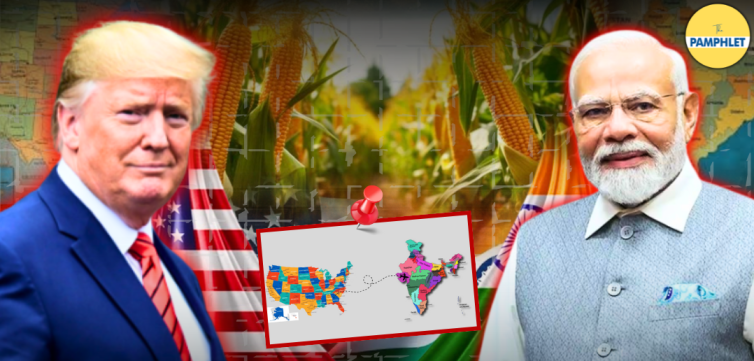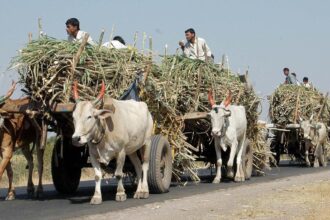India brags that they have 1.4 billion people. Why won’t 1.4 billion people buy one bushel of US corn? They put tariffs on everything.- US Commerce Secretary Howard Lutnick.
Rather than being frustrated, US Commerce Secretary Howard Lutnick should ask himself this question, Why won’t 1.4 billion people buy one bushel of US corn? Is there some issue on the US end?
The answer does not lie in Indian stubbornness, as Lutnik would like to believe, but in American assumptions. India doesn’t need US corn; we are not a corn-eating society like Mexico. We are an ‘agrarian country’ that proudly produces enough to meet our own demand. Unlike the 1960s, when shortages forced us to accept substandard grain under PL-480, today India stands strong, feeding itself, protecting its farmers, and refusing to be a dumping ground for genetically modified American surpluses.
This isn’t just about protectionism; it’s about India asserting its sovereignty and control over its own agricultural policies.
India’s Reality: Domestic Production and Dietary Patterns
For all the bluster in Washington, the truth is simple: India does not need American corn. Unlike rice or wheat, corn is not central to the Indian diet. We don’t eat corn in every meal, wheat is native to Northern India, while Rice is a staple in the southern part. In India, corn is used primarily for poultry feed, starch, and industrial purposes, areas where domestic production covers most demand.
In the year 2024-25, India imported just 0.97 million tonnes of corn, a fraction of national consumption. And even here, the bulk came from Myanmar, about 0.53 metric tonnes, and Ukraine, about 9.39 metric tonnes. From the United States? Not just a bushel, but about 1,100 tonnes of corn. The United States produces over 377 million tonnes of corn every year, but it remains invisible in the Indian market.
The reasons are fairly simple. First, Indian farmers are capable of meeting the country’s needs and others as well. When shortages occur, nearby suppliers like Myanmar step in with easy logistics and competitive prices. Second, the Indian government safeguards its farmers against cheap foreign grain and maintains its sovereignty. This isn’t some arbitrary trade wall, but a recognition that the backbone of India’s economy is its farming community, and opening the market up to substandard quality grains at a subsidized rate would devastate millions of livelihoods. If good-quality grain already exists in the country, why would the Indian government provide its citizens with substandard products?
The contrast with the past could not be clearer. In the 1960s, before the Green Revolution, India was dependent on Western aid shipments of wheat and rice, often of questionable quality. Today, India is self-reliant, producing enough grain to feed its people and export to other countries. Those who imagine that New Delhi will return to a position of dependence are living in a different century, perhaps akin to Howard Lutnick.
Protecting Farmers: Tariffs and the GM Ban
At the heart of this corn dispute lies something that the West refuses to acknowledge: India protects its farmers, not America’s surpluses. This is why New Delhi’s tariff structure is deliberate. Imports are allowed up to 0.5 million tonnes at a 15% duty, a safety valve for shortages.
But there is a bigger red line: genetically modified corn. Nearly 94% of US corn is GM, and India has drawn a hard line against both its import and its domestic cultivation. This is not just a matter of policy, but a commitment to the health and ecological well-being of our citizens. No government in New Delhi, especially one that thrives on nationalism, is going to risk farmer protests and public backlash by allowing GM corn into the food chain.
Here lies the irony: what Washington portrays as India’s “unfair barriers” are, in fact, the very policies that safeguard millions of rural households. The Green Revolution may have freed India from the humiliation of food aid, but it also entrenched a national consensus — that Indian farmers must never again be reduced to collateral damage in someone else’s trade surplus strategy.
For Lutnick and his colleagues, this is an inconvenient truth. India is not refusing American corn out of hostility. It is refusing because the price of admission is too high, compounded by factors such as farmer distress, political upheaval, and the erosion of food sovereignty.
Global Context: US Corn Finds No Buyers
Americans like Howard Lutnik like to portray India as a bully that only imposes tariffs, along with the delusion that India is funding the Russia-Ukraine war by importing Russian oil. But the truth is far more embarrassing for Washington: even global markets don’t want their corn.
For example, take China, once the largest buyer of US Corn, Beijing has slashed imports dramatically. In 2024, Chinese imports went from 5.21 billion dollars (in 2022) to just 331 million dollars. The reason isn’t just geopolitics, but economics and consumer resistance. Chinese demand has shifted, and the appetite for GM-heavy US Corn has collapsed.
Although the biggest shift for the US came in July 2025, it was a nightmare month for American grain exporters. Shipments of corn and wheat were rejected from Japan, South Korea, and Europe. Reasons being:
- Substandard quality
- Pesticide residue violations
- Inconsistent GMO labeling
- Failure to meet tightened phytosanitary rules
Japan and South Korea didn’t just cancel contracts; instead, they awarded Canada multi-year deals worth hundreds of millions of dollars. European buyers, with strict consumer standards, rerouted bulk shipments through Canada instead of the US Gulf Coast. By mid-year, the US Department of Agriculture admitted a 30% crash in corn exports compared to 2024.
Irony? US President Donald Trump, who had consistently berated Canada and expressed a desire to annex it, suddenly emerged as a major corn provider, replacing the US in the market. Canadian corn exports to Mexico alone surged 48%, reaching nearly $433 million. Japan signed a $450 million multi-year deal with Canadian producers. By tightening inspection and certification regimes, Ottawa positioned itself as the new reliable supplier, while American farmers faced cancelled contracts and rotting inventories.
The message is clear: India’s refusal is not an aberration — it is part of a global trend. If Japan, Korea, and Europe, all advanced economies with strict food standards, are rejecting American corn, then New Delhi’s ban on GM imports and tariff shields look not only justified but downright prudent. India, in fact, is ahead of the curve.
The Political Angle: Trump’s Tariffs and the Corn Agenda
Behind all the tough talk about “fair trade” lies a simpler truth: the United States has too much corn, and it needs someone to buy it. With China out of the picture and other markets rejecting shipments over quality and GMO concerns, India’s 1.4 billion consumers look like the last great hope.
That is why the corn debate cannot be separated from Donald Trump’s trade strategy. The rhetoric may be about reciprocity and tariff parity, but the underlying pressure is plain: “Buy our grain, or face the consequences.” Trump’s administration has openly linked progress on broader trade talks to India lowering tariffs and even reducing energy imports from Russia. But at its core, the grievance circles back to American farmers sitting on unsold surpluses.
Is this why Trump has hiked tariffs on Indian exports — not to fix a “trade imbalance,” but to arm-twist India into buying genetically modified American corn? The pattern is hard to ignore. First came the taunts from Lutnick, mocking India for not buying “one bushel of corn.” Then came the warnings that, unless tariffs were lowered, doing business with the “world’s greatest consumer” would become “a tough time.” The corn lobby is not just whispering in Washington’s ear — it is setting the tone of US foreign economic policy.
But what looks like leverage in Washington plays out very differently in New Delhi. Here, every kilogram of imported corn carries political weight. States like Bihar, where corn is a critical crop, are deeply sensitive to farmer sentiment. Especially with the Bihar assembly elections on the line, the Indian government will not bow down to the illogical pressure by the entitled West.
So, will India bow down?
Short answer: No, we don’t think so. Long answer: Howard Lutnick may sneer, and Donald Trump may threaten tariffs, but the reality is unshakable: India does not need American corn. We produce enough to feed ourselves. We safeguard our farmers through tariffs and regulations. And we refuse to gamble with food security by opening the door to genetically modified crops that even advanced economies are increasingly rejecting.
This is not the 1960s. India no longer waits for substandard shipments of grain under the shadow of Western aid. The Green Revolution transformed us from dependent to self-reliant, and no amount of arm-twisting from Washington can undo that hard-won sovereignty. If anything, the global backlash against US corn — from China to Japan to Europe — vindicates India’s stance.
At its core, this standoff is not about one bushel of corn. It is about who controls the future of Indian agriculture. Will it be dictated by the needs of American agribusiness, or by the millions of Indian farmers who till their own soil? For New Delhi, the choice is clear: protect farmers, preserve sovereignty, and reject pressure.
The United States may call that protectionism. India calls it survival — and dignity.









